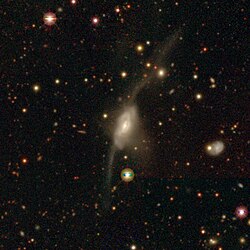| Arp 187 | |
|---|---|
 Arp 187 by legacy surveys. The small galaxy to the right is LEDA 980468 Arp 187 by legacy surveys. The small galaxy to the right is LEDA 980468 | |
| Observation data (J2000 epoch) | |
| Constellation | Eridanus |
| Right ascension | 5 03 53 |
| Declination | −10° 14′ 51″ |
| Redshift | 12095 ± 45 km/s |
| Apparent magnitude (V) | 15.3 |
| Characteristics | |
| Type | Radio Galaxy |
| Apparent size (V) | 0.8 x 0.6 |
| Other designations | |
| PGC 16691 | |
Arp 187 is a radio galaxy and merger remnant located in the constellation Eridanus. It is an interacting galaxy pair (MCG-02-13-040). It is included in the Atlas of Peculiar Galaxies in the category galaxies with narrow filaments.
The galaxy has two prominent radio lobes, however the emission of its AGN in X-ray is low, and so is the thermal output of the AGN torus as observed in infrared, suggesting that it has been quenched. The detection of a narrow line region (with dimensions up to 10 kpc) with still active emission mean that the AGN was still active up to at least 10 years ago. In the nucleus of Arp 187 is predicted to lie a supermassive black hole (SMBH) with estimated mass around 6.7 × 10 M☉. Further observations of such a SMBH with a quenched AGN were published in 2019.
References
- ^ "NASA/IPAC Extragalactic Database". Results for Arp 187. Retrieved 2006-10-26.
- "Simbad". Retrieved 2010-01-06.
- Ichikawa, Kohei; Ueda, Junko; Shidatsu, Megumi; Kawamuro, Taiki; Matsuoka, Kenta (1 February 2016). "Signs of active galactic nucleus quenching in a merger remnant with radio jets". Publications of the Astronomical Society of Japan. 68 (1): 9. arXiv:1510.06037. doi:10.1093/pasj/psv112.
- "Active Galactic Nucleus caught in the act of "dying" 〜light echo delivers the information before the death〜". Tohoku university. 1 April 2019.
- Ichikawa K, Ueda J, Bae H, et al. (9 January 2019). "Discovery of Dying Active Galactic Nucleus in Arp 187: Experience of Drastic Luminosity Decline within 104 yr". The Astrophysical Journal. 870 (2): 65. arXiv:1811.07447. Bibcode:2019ApJ...870...65I. doi:10.3847/1538-4357/aaf233. S2CID 119466692.
- "Discovery of a Dying Supermassive Black Hole Via a 3000-year-long Light Echo". Tohoku university. 4 June 2021.
External links
- Arp 187 on WikiSky: DSS2, SDSS, GALEX, IRAS, Hydrogen α, X-Ray, Astrophoto, Sky Map, Articles and images
- Photo of Arp 187
This galaxy-related article is a stub. You can help Misplaced Pages by expanding it. |